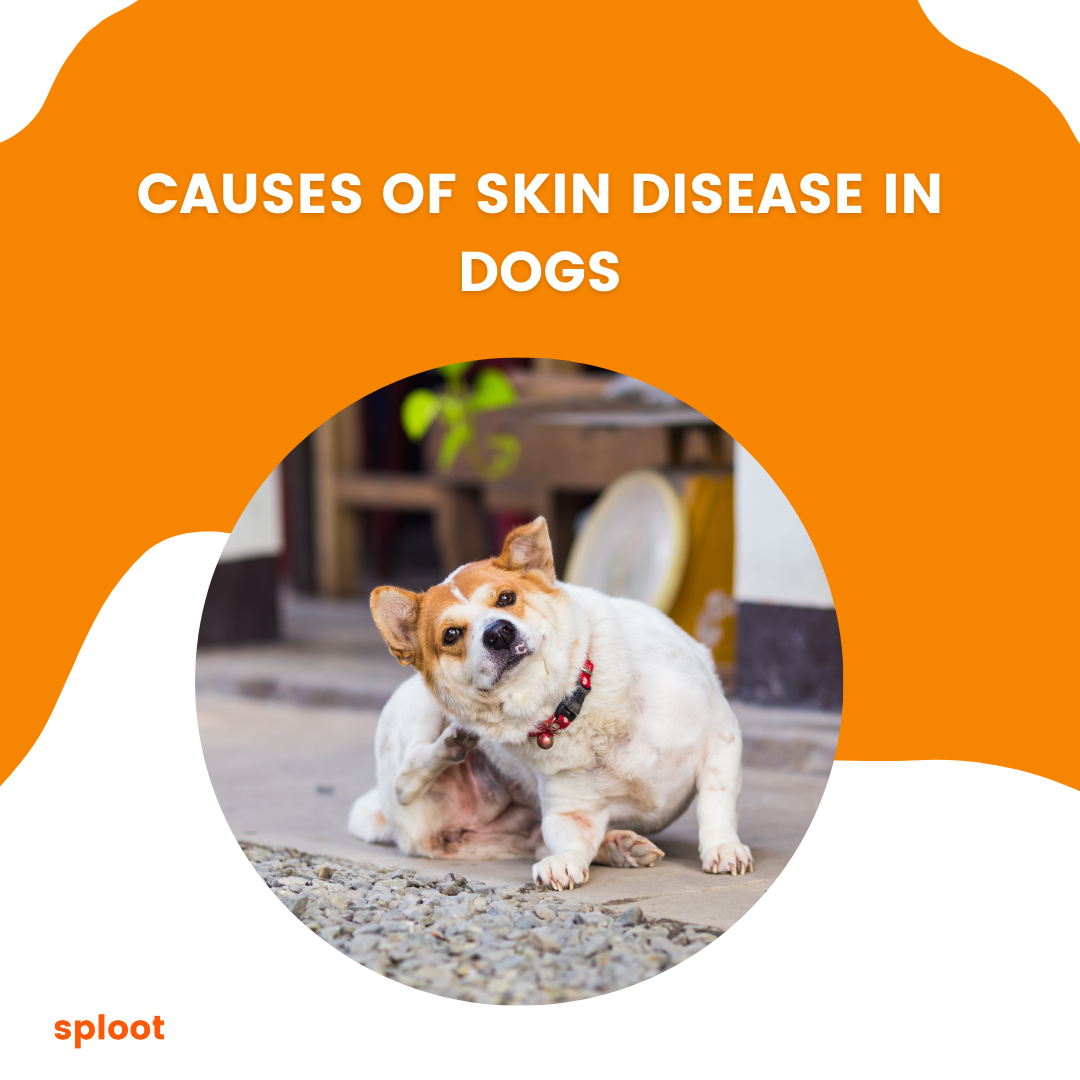Causes of skin diseases in dogs

It is a very common concern of the fur baby parents that their kiddos have some sort of kin infection. Or they are scratching themselves too much. Skin issues are one of the most common reasons why cat and dog owners seek veterinarian care. Itching due to skin disorders may cause a lot of discomfort in dogs, and itching can also be an indication of other underlying health issues.
Allergies from parasites like as fleas, environmental allergies, and unpleasant food responses are the most prevalent causes of skin disorders in cats and dogs.
Let’s talk about what could cause these.
• Fleas
Dogs are flea-sensitive and can develop allergies, resulting in significant skin illness. Even if your dog does not have fleas, flea allergies can be severe. Flea allergies cause pets to become extremely itchy after being bitten by a flea. The use of flea preventive treatments under the supervision of a veterinarian can aid in the avoidance of itching caused by flea allergic dermatitis. It is critical to treat not just your dog but also the surrounding environment. Because 90 percent of the flea population feeds on your dog, it is critical to treat places where your dog spends the most of its time, such as pet bedding and cleaning the home if your pet is allowed inside.
• Mange
Mange seems to be a skin ailment caused by a variety of mite species. Mite infections are not seasonal; they can develop at any time of year. Some mites can be detected in the skin and hair follicles. The symptoms of a mite infestation vary depending on the mite, and skin lesions can appear anywhere on the body. Demodectic mange is characterised by hair loss, bald areas, and lesions. Sarcoptic mange is characterised by extreme itching, hair loss, reddish skin, and ulcers.

• Ringworm
Despite its name, ringworm is caused by a fungal infection rather than a worm. It’s also very contagious and spreads to other animals and humans, so consult your veterinarian if you feel your dog is ill. In dogs, ringworm lesions often manifest as circular, crusty bald patches. Depending on the severity of the illness, treatment may include medicated shampoo or oral drugs.

• Allergies to Food
Dogs can develop food allergies as a result of what they consume. Protein allergies are the most frequent in dogs, with beef, dairy, chicken, and egg being the most common culprits. Food allergies in dogs are characterised by itchy skin on the face, paws, ears, and around the anus. Some dogs may exhibit gastrointestinal symptoms of food allergies, such as increased bowel movements and vomiting. To identify a food allergy, your dog will need to be fed a diet that it is not allergic to for 8-12 weeks; this is known as a food elimination trial. Your veterinarian’s diet could contain proteins that your dog is not sensitive to, or it may be a commercial hydrolyzed diet in which the proteins are so tiny that the body does not mount an allergic reaction to them. It is critical not to offer your dog any treats or human food while it is participating on a food elimination experiment, since this might interfere with the results.
• Allergies to the Environment
Environmental allergies are often seasonal and affect young canines under the age of three. Environmental allergies are typically inherited and are more prevalent in specific breeds. Contact with environmental allergens such as pollen, grass, or dust mites causes severe itching of the face, feet, ears, chest, and stomach. Environmental allergies are frequently diagnosed on the basis of exclusion. This means that adverse food responses, flea allergy dermatitis, infection, and other causes of skin issues may have to be cleared out before environmental allergens are blamed. Environmental allergies in dogs can also be evaluated using either an intradermal skin test or a blood test. Limiting your dog’s exposure to an allergy in the environment is preferable, but it is not always feasible! Environmental allergies are treated with a mix of drugs, medicated washes, environmental modifications, and skin-supporting foods.
• Skin Infections Caused by Bacteria
Bacterial skin infections are frequently a consequence of another allergy in dogs caused by fleas, their surroundings, or diet. They can happen if your dog scratches and breaks the skin, enabling germs to enter the wound. Your veterinarian will be able to identify the kind of infection and treat it appropriately.
• Infections with Yeast
Yeast is usually seen on dog skin, especially in the ear canal, between the toes, and around the anus. Dogs with floppy ears are the most vulnerable, although any dog can be harmed. The yeast organisms are opportunistic, which means they develop and infect the skin when the conditions are favourable. Infections can arise in high humidity conditions (for example, during the summer), after swimming, or as a secondary infection to allergic skin illness. Yeast infections cause itchy skin, hair loss, reddish patches, and skin thickening. Skin lesions are frequently accompanied by an unpleasant odour. Because yeast is a fungus, infections are often treated using ear ointments and medicated shampoos.
• Dandruff
Dandruff Dogs, like humans, can get dandruff. Dandruff is typically caused by dry skin or skin irritation in dogs. The food we give our pets has an impact on their skin and hair. Because the coat and skin are regularly lost and regenerated, the skin has a high protein need. It is essential to provide your dog a diet rich in high-quality protein sources in order to maintain healthy skin and hair. Diets rich in omega 3 and 6 fatty acids, as well as vitamins (e.g., B group vitamins) and minerals (e.g., zinc), have been shown to support healthy skin and hair in dogs.
• Autoimmune Diseases
Skin diseases that refuse to heal are sometimes caused by underlying immunological illnesses in which your dog’s immune system destroys cells in its own body. Autoimmune disorders in dogs include Canine Lupus and Pemphigus. Skin lesions are often severe, with ulcerations and crusting, and your dog may be in general distress. Your veterinarian will be able to diagnose and treat you.